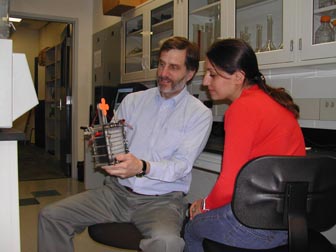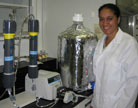KAPPE ENVIRONMENTAL ENGINEERING LABORATORIES
  |
The Kappe Environmental Engineering laboratories at Penn State cover an area of approximately 16,000 sq. ft., including a 2,000 sq. ft. laboratory at the University Wastewater Treatment Plant (less than one mile from the Department of Civil and Environmental Engineering).
The Kappe Labs include general research lab areas, dedicated microscopy and dark rooms, multiple temperature control rooms, and general-use rooms for instrumentation and preparations. Major equipment in the Kappe labs includes an atomic absorption spectrophotometer with flame and graphite furnace, gas chromatographs, ion chromatographs, high-performance liquid chromatograph, UV spectrophotometers, scintillation counter, carbon analyzer with NDIR detector, particle counters, pore size distribution and surface-area analyzer, laser zeta meter, streaming-current detector, computer-aided titrimeter, an Axiophot microscope with image analysis and photometric detection, anaerobic and aerobic respirometer systems, anaerobic glove boxes, PCR thermocyclers, and electrophoresis and imaging systems.
Equipment is also available at various locations on campus for other analyses, including laser Ramanspectroscopy, nuclear magnetic resonance imaging, calorimetry, thermogravimetric analysis, scanning electron microscopy (SEM), transmission electron microscopy (TEM), x-ray diffraction spectrophotometry (XRD), x-ray fluorescence spectrophotometry (XRF), and inductively coupled plasma emission spectrophotometry (ICP).
Go on a virtual Tour of the Kappe Labs, or view the Kappe Lab Guides for important safety and operating procedures while working in the labs.
To learn more about the types of research going on in the Kappe Labs, visit the Environmental Engineering group webpage.
